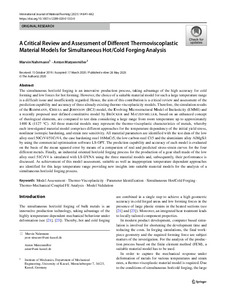| dc.date.accessioned | 2021-07-19T14:17:54Z | |
| dc.date.available | 2021-07-19T14:17:54Z | |
| dc.date.issued | 2020-05-26 | |
| dc.identifier | doi:10.17170/kobra-202107024232 | |
| dc.identifier.uri | http://hdl.handle.net/123456789/13013 | |
| dc.description.sponsorship | Gefördert im Rahmen des Projekts DEAL | ger |
| dc.language.iso | eng | eng |
| dc.rights | Namensnennung 4.0 International | * |
| dc.rights.uri | http://creativecommons.org/licenses/by/4.0/ | * |
| dc.subject | model assessment | eng |
| dc.subject | thermo-viscoplasticity | eng |
| dc.subject | parameter identification | eng |
| dc.subject | simultaneous hot/cold forging | eng |
| dc.subject | thermo-mechanical coupled FE analysis | eng |
| dc.subject | model validation | eng |
| dc.subject.ddc | 620 | |
| dc.title | A Critical Review and Assessment of Different Thermoviscoplastic Material Models for Simultaneous Hot/Cold Forging Analysis | eng |
| dc.type | Aufsatz | |
| dcterms.abstract | The simultaneous hot/cold forging is an innovative production process, taking advantage of the high accuracy for cold forming and low forces for hot forming. However, the choice of a suitable material model for such a large temperature range is a difficult issue and insufficiently regarded. Hence, the aim of this contribution is a critical review and assessment of the prediction capability and accuracy of three already existing thermo-viscoplasticity models. Therefore, the simulation results of the Bammann, Chiesa and Johnson (BCJ) model, the Evolving Microstructural M odel of I nelasticity (EMMI) and a recently proposed user defined constitutive model by Bröcker and Matzenmiller, based on an enhanced concept of rheological elements, are compared to test data considering a large range from room temperature up to approximately 1400 K (1127 ∘C). All three material models may represent the thermo-viscoplastic characteristics of metals, whereby each investigated material model comprises different approaches for the temperature dependency of the initial yield stress, nonlinear isotropic hardening, and strain rate sensitivity. All material parameters are identified with the test data of the low alloy steel 50CrV4/51CrV4, the case hardening steel 16MnCr5, the low carbon steel C15 and the aluminium alloy AlMgSi1 by using the commercial optimisation software LS-OPT. The prediction capability and accuracy of each model is evaluated on the basis of the mean squared error by means of a comparsion of real and predicted stress-strain curves for the four different metals. Finally, an industrial oriented hot/cold forging process for the production of a gear shaft made of the low alloy steel 51CrV4 is simulated with LS-DYNA using the three material models and, subsequently, their performance is discussed. As achievement of this model assessment, suitable as well as inappropriate temperature dependent approaches are identified for this large temperature range providing new insights into suitable material models for the analysis of a simultaneous hot/cold forging process. | eng |
| dcterms.accessRights | open access | |
| dcterms.creator | Nahrmann, Marvin | |
| dcterms.creator | Matzenmiller, Anton | |
| dc.relation.doi | doi:10.1007/s12289-020-01553-0 | |
| dc.relation.projectid | Ma1186/5-2 | |
| dc.subject.swd | Viskoplastizität | ger |
| dc.subject.swd | Thermomechanische Eigenschaft | ger |
| dc.subject.swd | Parameteridentifikation | ger |
| dc.subject.swd | Schmieden | ger |
| dc.subject.swd | Kaltumformen | ger |
| dc.subject.swd | Warmumformen | ger |
| dc.type.version | publishedVersion | |
| dcterms.source.identifier | eissn:1960-6214 | |
| dcterms.source.issue | Issue 4 | |
| dcterms.source.journal | International Journal of Material Forming | eng |
| dcterms.source.pageinfo | 641-662 | |
| dcterms.source.volume | Volume 14 | |
| kup.iskup | false | |


